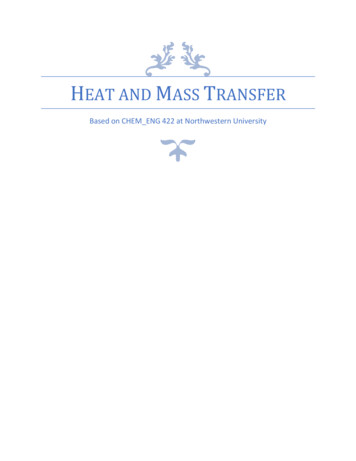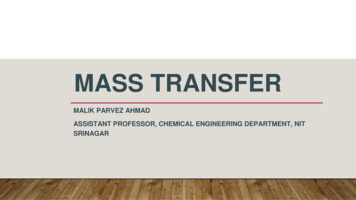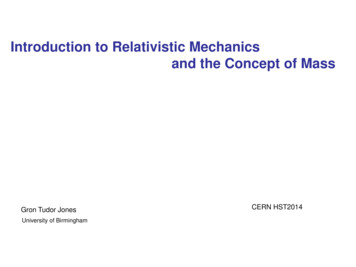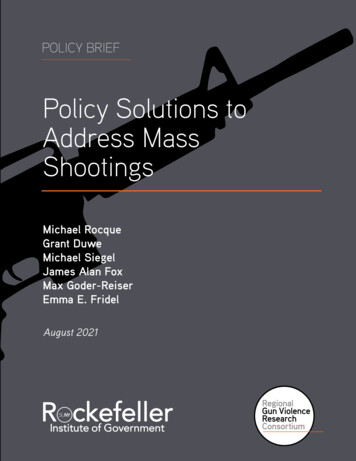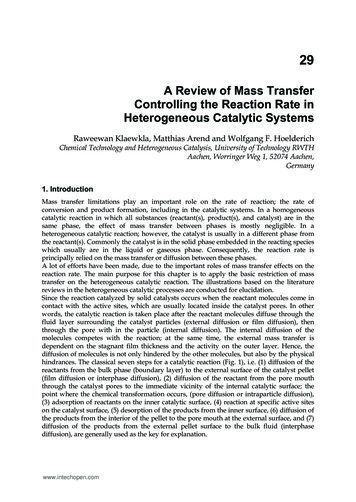
Transcription
29A Review of Mass TransferControlling the Reaction Rate inHeterogeneous Catalytic SystemsRaweewan Klaewkla, Matthias Arend and Wolfgang F. HoelderichChemical Technology and Heterogeneous Catalysis, University of Technology RWTHAachen, Worringer Weg 1, 52074 Aachen,Germany1. IntroductionMass transfer limitations play an important role on the rate of reaction; the rate ofconversion and product formation, including in the catalytic systems. In a homogeneouscatalytic reaction in which all substances (reactant(s), product(s), and catalyst) are in thesame phase, the effect of mass transfer between phases is mostly negligible. In aheterogeneous catalytic reaction; however, the catalyst is usually in a different phase fromthe reactant(s). Commonly the catalyst is in the solid phase embedded in the reacting specieswhich usually are in the liquid or gaseous phase. Consequently, the reaction rate isprincipally relied on the mass transfer or diffusion between these phases.A lot of efforts have been made, due to the important roles of mass transfer effects on thereaction rate. The main purpose for this chapter is to apply the basic restriction of masstransfer on the heterogeneous catalytic reaction. The illustrations based on the literaturereviews in the heterogeneous catalytic processes are conducted for elucidation.Since the reaction catalyzed by solid catalysts occurs when the reactant molecules come incontact with the active sites, which are usually located inside the catalyst pores. In otherwords, the catalytic reaction is taken place after the reactant molecules diffuse through thefluid layer surrounding the catalyst particles (external diffusion or film diffusion), thenthrough the pore with in the particle (internal diffusion). The internal diffusion of themolecules competes with the reaction; at the same time, the external mass transfer isdependent on the stagnant film thickness and the activity on the outer layer. Hence, thediffusion of molecules is not only hindered by the other molecules, but also by the physicalhindrances. The classical seven steps for a catalytic reaction (Fig. 1), i.e. (1) diffusion of thereactants from the bulk phase (boundary layer) to the external surface of the catalyst pellet(film diffusion or interphase diffusion), (2) diffusion of the reactant from the pore mouththrough the catalyst pores to the immediate vicinity of the internal catalytic surface; thepoint where the chemical transformation occurs, (pore diffusion or intraparticle diffusion),(3) adsorption of reactants on the inner catalytic surface, (4) reaction at specific active siteson the catalyst surface, (5) desorption of the products from the inner surface, (6) diffusion ofthe products from the interior of the pellet to the pore mouth at the external surface, and (7)diffusion of the products from the external pellet surface to the bulk fluid (interphasediffusion), are generally used as the key for explanation.www.intechopen.com
668Mass Transfer - Advanced AspectsFig. 1. Individual steps of a simple, heterogeneous catalytic fluid–solid reaction A1 A2carried out on a porous catalyst (Dittmeyer & Emig, 2008)The adsorption, surface reaction, and desorption are sequential steps. However, when achemical reaction occurs on a surface, the rate of mass transfer to the reactive surface(intraparticle diffusion) is in steady state and equal to the rate of the reaction.If diffusion or mass transfer steps (steps 1, 2, 6, and 7) are very fast, there is no resistance forthe mass transfer from the bulk to the particle surface and from the particle surface to theactive site in the pore. The concentration around the catalyst sites is supposed to be the sameas that of the bulk one. Under these conditions, the mass transferring steps do not affect thereaction rate. The rate of reaction can be calculated from the reaction mechanism assumingthat the concentration at the catalyst site is the same as that of the bulk.If diffusion from the bulk to the catalyst surface is slow, e.g. the reactants are in the gasphase while the catalyst is in the solid phase, then the external mass transfer resistance ishigh and becomes an important factor with respect to the overall reaction rate. Nevertheless,the external mass transfer resistance is strongly depended on the flow conditions, e.g.temperature, pressure, and superficial velocity, in the reactor and the particle size of thecatalyst (Fogler, 2006a). Varying these parameters can help to reduce the external masstransfer resistance.In case of the internal diffusion effects are significant and there is no external mass transferresistance then the concentration profile would vary across the catalyst pellet.In this chapter, the influences of the mass transfer, i.e. external and internal diffusion,controlling the rate of heterogeneous catalysis reaction are focused. The important factorsfor mass transfer such as the flow rate conditions (temperature, pressure, and solvent) andthe catalyst deactivation are discussed. The types of reactors effecting the enhancement ofthe mass transferring rate are also communicated. The objective is to summarize the mainconcepts and formulas for the rate of reaction, which identified to be limited by the masstransfer resistance.2. Influences of external mass transferWhen a chemical reaction occurs on an active surface, the rates of intraparticle diffusion andchemical reaction are in steady state and simultaneously take place. For a given component“A”, the reaction rate can be defined as:www.intechopen.com
A Review of Mass Transfer Controlling the Reaction Rate in Heterogeneous Catalytic Systems(rA kcA x bA x sA)669(1)where rA (mol L-2 t-1) is the reaction rate of the component “A”, kcA (mol L-2 t-1) is the masstransfer coefficient in a binary system, xAb is the mole fraction of species “A” in gas bulk, andxAs is the mole fraction of species “A” in equilibrium with adsorbed “A” (Löffler & Schmidt,1977).In order to measure rA, the value of (xAb - xAs) must be small. In other words, the masstransfer resistance must be small compared to the surface reaction resistance which can beneglected. Löffler & Schmidt (1975) illustrated that in order to determine the reaction rateswith only 10% error due to mass transfer, the Damköhler number (Da) should be less than0.1. For a first order reaction, Da can be calculated with:Da rA / kc b rA xA kc (2)The value of Da is varied between zero and infinity (the higher value of rA/kc than xAb isphysically impossible). In a system in which Da is higher than 3, the reaction becomes masstransfer controlled. And the rate measured under these conditions should represent ameasurement of kc. Using the heat and mass transfer analogy and the correlation presentedby Kyte et al. (1953) with elimination of the insensitive term, the mass transfer coefficient forthe natural convection to horizontal wires becomes:kc T 0.5Dw 1(3)where T and Dw represent in temperature (K) and wire diameter (cm), respectively. Whenthe temperature difference between gas and catalyst is small, the forced convection is themain mechanism for mass transfer. The mass transfer coefficient “kc” presented by Bird et al.(2002) can be calculated as:kc v0.3T 0.5Dw 0.7 P 0.3(4)where v is the gas velocity and P is the pressure.The mass transfer coefficient, kc, can be calculated by the correlations of the experimentaldata (Satterfield, 1970 as cited in Forni, 1999), between the Sherwood (Sh kcDp/DAB),Schmidt (Sc μ/(ρDAB), and Reynolds (Re Dpρus/μ) numbers. Wherein, “kc” is the masstransfer coefficient for the system in which the reactant is the liquid phase (for the masscoefficient of a gaseous reactant “kg”, it can be calculated from the relationship ofkg kc/RT). “Dp“(cm) is the diameter of the catalyst particle. “DAB“(cm2 s-1) is the diffusioncoefficient or diffusivity of component “A” in component “B”. “ρ” (g cm-3) and “μ” (Pa s) arethe density and viscosity of the fluid, respectively. “us“ (cm s-1) is the superficial flow rate ofthe fluid referred to the overall cross section of the catalyst bed, which is calculated in theabsence of the catalyst. These correlations are in the terms of the Colburn “J” factor (i.e. JD)as a function of the Reynolds number:JD www.intechopen.comShReSc 1/3(5)
670Mass Transfer - Advanced AspectsJD is a function of the Reynolds number. For the gaseous reactants whereby 3 Re 2000and the interparticle void fraction (ϵ) of the bed of the particles 0.416 ϵ 0.788, JD can becalculated as:J Dε 0.357 Re 0.359(6)For the liquid reactants by which 55 Re 1500 and 0.35 ϵ 0.75:J Dε 0.25Re 0.31(7)and for the liquid reactants with 0.0016 Re 55J Dε 1.09 Re 0.67(8)For a heterogeneously catalysed reaction, the reactants can be in the different phases (gasand liquid); in other words, comprising of the binary diffusion, the pressure of the gaseousreactant(s) influences the reaction rate as in the term of DAB. By means of the solubility ofgaseous reactant(s) in the liquid phase affects a higher reaction rate then improves theconversion.Additionally, a higher reaction temperature influences the sorption processes on the catalystsurface, subsequently influences the reaction rate. The equations for predicting the gas,liquid, and solid diffusivities as the function of temperature and pressure are given in Table1. It should be noted that the Knudsen, liquid, and solid diffusivities are independent of thetotal pressure.PhaseOrder of Magnitude(cm2 s-1)Gas- Bulk10-1- Knudsen10-2Liquid10-5Solid10-9Temperature and Pressure Dependences aDAB (T2 , P2 ) DAB (T1 , P1 ) T DA (T2 ) DA (T1 ) 2 T1 DAB (T2 ) DAB (T1 )P1 T2 P2 T1 Eq.1/2(9)1/2μ1 T2 μ2 T1 (10)1/2 E T T1 DAB (T2 ) DAB (T1 ) exp D 2 R T1T2 (11)(12)μ1 and μ2 are liquid viscosities at temperatures T1 and T2, respectively; ED is the diffusion activationenergyaTable 1. Diffusivity relationships for gases, liquid, and solid (Fuller et al. 1966; Reddy &Doraiswamy, 1967; Perry & Green, 1999, as cited in Fogler, 2006a)For a binary mixture, the single diffusivity DAB can be evaluated from the experimental datarelated to the Schmidt number. However, most practical reactions involve multicomponentmixtures, of which rigorous handling is more complicated. Since the flux of a given chemicalwww.intechopen.com
A Review of Mass Transfer Controlling the Reaction Rate in Heterogeneous Catalytic Systems671species “j” (Nj) is driven not only by its own concentration gradient, but also by those of allthe other species. For ideal gas mixtures, the kinetic theory leads to the Maxwell-Stefanequation as demonstrated in Eq. (13) (Maxwell, 1866; Stefan, 1871, as cited in Froment &Bischoff, 1979):N j C i D jk y k yi N k , j 1, 2,., N 1N 1Nk 1k 1(13)in which the last term accounts for bulk flow of the mixture. The exact form of Djk dependson the system under study. The technique for solving the equation is done by using matrixmethods.In an empirical binary mixture of ideal gases, the diffusivity can be expressed in terms of thechemical potential gradient (μi) (Krishma & Wesselingh, 1997). Under isothermal conditionswith a constant pressure of a species “i”, referred to the Maxwell-Stefan equation, thediffusivity “D” can be derived from: y1y N y 1N 2 T , P μ 1 2 1RTCt D(14)where y1 and y2 are the mole fractions of the species “1” and “2”, Ct is total molarconcentration of the fluid mixture (mol m-3), and D is defined as the Maxwell-Stefandiffusivity (m2 s-1).For a non-ideal fluid mixture, the component activity coefficients are introduced to expressthe left member of Eq. (14) as: y1 ln γ 1 T , P μ 1 1 y 1 x1 Γ y1RT y1 (15)where γ1 is the activity coefficient of species “1” (dimensionless) and Γ is the thermodynamiccorrection factor portraying the non-ideal behavior. Combining of Eq. (14) and (15) afterintroducing y2 (1 – y1), Eq. (16) is obtained:N 1 y1N t Ct DΓ y1(16)D (D( x1 1) )x1 (D( x1 0) )(1 x1 )(17)For highly non-ideal mixtures, the thermodynamic factor Γ strongly depends on the mixturecomposition and vanishes in the region of the critical point.For gaseous mixtures at low to moderate pressures and for thermodynamically ideal liquidmixtures, the thermodynamic factor Γ is equal to 1 and the Maxwell-Stefan diffusivity isindependent of composition.For highly non-ideal liquid mixtures, the thermodynamic factor Γ strongly depends on thecomposition of the mixture. An empirical formula for the composition dependence is:where the bracketed terms are the infinite dilution values of the Maxwell-Stefan diffusivityat either ends of the composition range and x1 is the liquid mole fraction of the species “1”.The mechanistic picture developed for the diffusion in a two-component system can beextended to the general multicomponent cases, analogous to Eq. (14) as:www.intechopen.com
672Mass Transfer - Advanced Aspects n y N yNn y J y Jyij ii jj ii j, i 1, 2,., n T μi RTCt DijCt Dijj 1j 1j 1(18)j 1where the second equality holds irrespective of the reference velocity frame chosen for thediffusion process.The examples for the heterogeneous catalysis which are strongly limited by the externalmass transfer are the oxidation of alkanes (C2 – C4) (Hiam et al., 1968 as cited in Löffler &Schmidt, 1977) and ammonia decomposition (Löffler & Schmidt, 1976)3. Influences of internal mass transferIn a heterogeneously catalysed reaction, the mass transfer of the reactants first takes placefrom the bulk fluid to the external surface of the pellet (Fogler, 2006b). The reactants thendiffuse from the external surface into and through the pores within the pellet to the catalyticsurface of the pores, in which the reaction occurs. Generally, the overall reaction rate isaffected by the external surface diffusion only for the low temperature process (Thomas &Thomas, 1997). Under high temperature conditions, a total pressure difference across thepore usually presents, generating a forced flow in pores. Depending on the catalyst poresize, three diffusion modes can be observed (Forni, 1999). When the pore diameter dp ismuch larger than the mean free path “λ” of the diffusing molecules, the diffusion takes placein the usual way as observed outside the pores (bulk or molecular diffusion). When dp λ,the diffusing molecules hit the pore walls more frequently than the other molecules(Knudsen diffusion). In addition, in the microporous solids, such as zeolites, the porediameter of which is close to the size of the reactant molecule. Thus, the reactant moleculescan only diffuse in the pores by remaining constantly in contact with the pore walls (surfaceor configurational diffusion).According to the mole balance for diffusion and reaction inside the catalyst pellet asdescribed by Fick's law, the internal diffusion rate “NA” (mol cm-2 s-1) is defined as: C N A De A z (19)where CA is the number of moles of component “A” per unit of the open pore volume, z isthe diffusion coordinate, with the effective diffusion coefficient (diffusivity) De (cm2 s-1) isgiven by:111 De Db , e Dk , e(20)where Db,e and Dk,e are the effective diffusion coefficients for bulk and Knudsen diffusions,respectively. Db,e and Dk,e can be calculated using the equations as demonstrated bySatterfield (1970) as:Db , e DbθDk , e 1.94 10 4www.intechopen.comτθ2τ Sg ρ p(21)TM(22)
A Review of Mass Transfer Controlling the Reaction Rate in Heterogeneous Catalytic Systems673where Db (cm2 s-1) is the bulk diffusion coefficient, θ is the internal void fraction of the solidparticle, τ is the tortuosity factor of the pores, Sg (cm2 g-1) is the specific surface area of thecatalyst, ρp (g cm-3) is the particle density, T (K) is the reaction temperature, and M (g mol-1)is the molecular mass of the diffusing species.In a multicomponent system, the Maxwell-Stefan equation is more generally used than theFick’s law for providing the diffusivity data. The interesting example is the application ofthe Maxwell-Stefan equation for diffusion in zeolites (Kapteijn et al., 2000). The extendedapproach to describe the surface diffusion of the adsorbed molecules for an n-componentsmixture is started with Eq. (23) (Krishna, 1990, 1993a, 1993b, as cited in Kapteijn et al., 2000): μi RT θ jnui u jj 1j 1Dijs RTuiDis, i 1, 2,., n(23)where μi is the force acting on the species “i” tending to move along the surface with avelocity ui . The first term on the right-hand side reflects the friction exerted by adsorbate “j”on the surface motion of species “i”, each moving with velocities uj and ui with respect to thesurface, respectively. The second term reflects the friction between the species “i” and thesurface. Dijs and Dis represent the Maxwell-Stefan surface diffusivities. The fractional surfaceoccupancies are given by “θi”:θi qi(24)q satwhere qi represents the loadings of component “i” in zeolite and qsat is referred to thesaturation loading (molecules per unit cell or mol kg-1).Eq. (23) has been successfully applied to describe the transient uptake in zeolites, such as thesingle-component adsorption on MFI-type zeolites (silicalite-1 and ZSM-5 etc.), carbonmolecular sieves, and in zeolitic membrane permeation.For a first-order catalytic reaction, the reaction rate rA (mol cm-3 s-1) referred to the unitvolume of catalyst particle is given by:rA ksSvC A(25)where ks (cm s-1) is the reaction rate constant and Sv (cm2 cm-3) is the surface area per unitparticle volume. For a spherical catalyst pellet with a radius r1 (cm) (Fig. 2), the profile of thereactant concentration as a function of radius can be calculated using a mass balance ofwhich referred to the spherical shell thickness dr and r (Fogler, 2006b).r1rCAsdrFig. 2. Shell balance on a catalyst pelletwww.intechopen.com
674Mass Transfer - Advanced AspectsThe integration is easily managed by introducing a dimensionless term known as Thielemodulus (Φ), Eq. (26).Φ r1 1ksSvCVAsDe(26) rΦ C Assinh r sinh Φ r1 (27)where CAs is the reactant concentration at the external particle surface and ν is the reactionorder. The parameter Φ represents the ratio of reactivity over diffusivity of the reactingspecies. For first-order reactions, Φ is independent of reactant concentration. The result ofthe integration is implicit as:CA For a low value of Φ, the concentration everywhere inside the pore is high. In other words,the diffusion coefficient is very high as compared to the reaction rate. The concentration isuniform across the pore and almost equal to the surface concentration CAs. The reaction ratein comparison to the diffusion rate is very low. Hence, one can say that the surface reactionis the rate determining step for a reaction having a low value of Φ.For a high value of Φ, the reaction rate is fast compared to the diffusion rate. The internaldiffusion rate results in the distinctive concentration gradients. Therefore, the reaction rate isevaluated based on the concentration existing at each spatial position inside the pore, not atthe surface.In comparison the relationship between diffusion and reaction limitations, the internaleffectiveness factor eta (η) is defined (Pushpavanam, 2009).η actual reaction ratereaction rate assuming no diffusion resistance(28)The magnitude of the effectiveness factor is range from 0 to 1. For a first-order reaction, theeffectiveness factor can be derived from:η r volume of catalyst particle rA A rAs rAs volume of catalyst particle(29)For a spherical particle:4 3 dC π r1 rA 4π r12 N A 4π r12 De A 3 dr r r1(30)Combination of Eq. (30) and (27) results in: C Φ 14 31 π r1 rA 4π r12 De As rTgh3ΦΦ 1 For the absence of any diffusion resistance:www.intechopen.com(31)
A Review of Mass Transfer Controlling the Reaction Rate in Heterogeneous Catalytic Systems4 34π r1 rAs π r12C As ksSv33675(32)Substitution of Eq. (31) and (22) in (29) results in:3De Φ 11 2r1 ksSv TghΦ Φ (33)η 3 11 Φ TghΦ Φ (34)η 3( Φ coth Φ 1)Φ(35)η Using the definition of Φ in Eq. (26), then Eq. (30) becomes:On the other hand:The dependence of η on Φ for the first-order reaction is shown in Fig. 3.ΦFig. 3. Effectiveness (η) of a catalyst as a function of Thiele modulus (Φ) for the sphericalparticles (Fogler, 2006b)In many circumstances, one is interested to identify the step, determining the reaction rate.The Weisz–Prater criterion (CWP) is used to measure the rate of reaction in order todetermine whether the internal diffusion is limiting the reaction. This criterion can becalculated with the following equation:C WP ηΦ 2 3 ( Φ coth Φ 1 )(36)For CWP 1, there is no diffusion limitation and consequently no concentration gradientexists within the pellet. However, for CWP 1, the reaction is tremendously limited by theinternal diffusion.www.intechopen.com
676Mass Transfer - Advanced Aspects4. Effect of the catalyst deactivation on mass transferThe rate of heterogeneous catalytic reaction usually decreases with the time-on-stream dueto the catalyst deactivation. The catalyst deactivation takes place by means of severalreasons; for example, the products or by-products produced in the system plug the catalystpores, subsequently, limit the mass transfer process from the external pore mouth to theinternal catalyst surface. In some cases, the foreign molecules, such as coke, are formedunder the reaction conditions, deposit on the active surface (fouling or poisoning), and thenrender the catalyst activity. The presence of an appropriate solvent can assist to prevent orreduce these deactivation problems.Generally, there are three categories of deactivation mechanisms of which the loss of thecatalytic activity is traditionally divided (Fogler, 2006c), i.e. sintering or aging, fouling orcoking, and poisoning.4.1 Deactivation by sintering (aging)Deactivation by sintering is the loss of the catalytic activity due to the loss of the activesurface area or of a crystal phase transformation resulting from a prolonged exposure tohigh temperature conditions. The active surface area may be lost either by crystalagglomeration and growth of the metals deposited on the support or by narrowing orclosing of the pores inside the catalyst pellet. A change in the surface structure may alsoresult from either surface recrystallization or the formation or elimination of surface defects(active sites). The reforming of alkanes over platinum on alumina is an example of catalystdeactivation as a result of sintering.Deactivation by sintering, in some cases, is a function of the mainstream gas concentration.The most commonly used is the second order with respect to the present activity:rd kd a 2 dadt(37)where a is the catalyst activity as the function of time, a(t), and kd is the constant for thesintering decay.The amount of sintering is usually measured in the term of the active area of the catalyst, Sa:Sa Sa 01 kd t(38)4.2 Deactivation by coking or foulingDeactivation by coking or fouling is commonly involved in the reactions of hydrocarbons,such as catalytic reforming, hydrogenation, oxidation etc. The decay mechanism resultsfrom a carbonaceous (coke) material depositing on the surface of the catalyst. The amount ofcoke on the surface after a certain time can be found with the following empiricalrelationship (Voorhies, 1945 as cited in Fogler, 2006c):CC At n(39)where CC is the concentration of carbon on the surface (g m-2) while n and A are foulingparameters, which are the functions of feed rate. This expression can be used for a widevariety of catalysts and feed streams.www.intechopen.com
A Review of Mass Transfer Controlling the Reaction Rate in Heterogeneous Catalytic Systems6774.3 Deactivation by poisoningDeactivation by this mechanism occurs when the poisoning molecules (P) becomeirreversibly chemisorbed on active sites (S), thereby reducing the number of sites availablefor the main reaction. The poisoning molecule can be a reactant and/or a product in themain reaction, or it may be an impurity in the feed stream. The reaction rate for poisoning is:rd k d CP a 2'mqdadt(40)where m and q are the reaction orders.5. Effect of reactor types on mass transferAs the result of the kinetics data obtained from the integral reactors under the conditionswhich limited by mass and heat transfer cannot be used for formulating the meaningfulkinetic expressions. In other words, for any kinetic measurements, modeling, and the typicalapproaches to the reactor rate calculations, the mass transfer limitation is always assumed tobe of less effect that can be negligible. An appropriate type of reactor characteristically helpsto enhance the mass transferring rate of the system. Accordingly, the design of any reactorgenerally concerns on the need for eliminating heat and mass transfer effects or accountingthem in the suitable manner.Several types of reactors exist for the heterogeneous catalytic reactions. These include fixedbed reactors, tubular catalytic wall reactors, and fluidized bed reactors. However, for gasliquid-solid reactions, the reactor types (e.g. trickle bed reactor or bubble column reactor)are usually developed for the specific reaction conditions (Levenspiel, 1999).The continuous flow-through reactors/plug flow reactor (tubular and column) are widelyused for the heterogeneous systems. The tubular reactors permit a vigorous heat exchangein the reaction zone and ensure a uniform residence time for all particles in the flow.Whereas, the column reactors are structurally less suited for vigorous heat exchange andtherefore are used in those cases where an addition (or removal) of heat to the reaction zoneis either unnecessary or is carried out on a limited scale. In column reactors, it is veryimportant to have a uniform distribution of flow through the cross section of the column. Insuch a case, the flow-through reactors are usually equipped with the circulation loops forrecycling any substances which are unreacted.The reactors in which the diffusional effect can be precisely predicted are the tubular flow orplug-flow reactor (PFR). These reactors are sometimes filled with the solid packing (packedbed reactor, PBR), in order to accelerate the mass transfer between phases and reduce thevariation in residence time of the reactant particles. In multiphase catalytic reaction, PBR isregularly used as a model reactor. The PBR can be operated either with a continuous gas orin a distributed liquid phase (trickle operation; in which the catalyst is stationary, so calledtrickle-bed reactor (TBR)) or with a distributed gas and a continuous liquid phase (bubbleoperation; in which the catalyst is suspended in the liquid phase) flowing through a packedbed of the catalyst, so called fixed-bed like reactor (FBR). The directions of gas and liquidflows in the system, i.e. cocurrent downflow, cocurrent upflow, and countercurrent flow(Fig. 4 (A) - (C)), are considered as one of the most important factors.An alternative reactor type is the slurry reactor, a vessel in which the gaseous reactant isdispersed into a liquid phase containing the suspended solid catalyst. At high ratio of fluid-www.intechopen.com
678Mass Transfer - Advanced Aspectsfeed flow rate to the reactor diameter, the gas-liquid-solid reactor is often termed anebullating-bed (a high solid concentration type of fluidized bed reactor in which catalystparticles are held in suspension by the upward movement of the liquid reactant and gasflow), Fig. 4 (D), or bubble column reactor, as a low solid concentration, Fig. 4 (E).Fig. 4. Various types of reactors with direction of gas (G) and liquid (L) flows for thereactions catalyzed by the solid catalysts (Levenspiel, 1999)Some special chemical reactor types are fluidized (Fig. 5. (A)) and moving (Fig. 5 (B)) bedreactors, which have characteristics that set them apart from the other reactors. Theadvantages of these reactors include the possibility of a continuous intake of fresh solidphase and removal of depleted solid phase, a high rate of heat exchange, the lack ofdependence of the speed of the fluidizing agent (gas, vapour, or liquid), and a wide range ofproperties of solid particles (including suspensions and pastes) and fluidizing agents.However, the use of reactors with fluidized and moving beds is limited. This is because theydo not ensure a uniform residence time of the particles of the two phases in the beds, and donot preserve the solid-phase properties. In addition, they require the powerful recoveryequipment for fines.5.1 Slurry reactorThe three phase (gas and liquid as the reactants with solid as the catalyst) catalytic slurryreactors are commonly used in industry for a wide variety of processes, such as oxidation,hydrogenation, carbonylation, and pollution control (Ramachandran & Chaudhari, 1980). Awww.intechopen.com
A Review of Mass Transfer Controlling the Reaction Rate in Heterogeneous Catalytic Systems679number of steps such as gas-liquid mass transfer, liquid-solid mass transfer, intraparticlediffusion, and chemical reaction are involved for the reaction. A useful concept foranalyzing these kind of heterogeneous catalysis reactions is the overall effectiveness factor(Ω) which incorporated the effects of all transport resistances (internal and external).(a)(b)Fig. 5. Fluidized-bed (a) and moving-bed (b) reactors (Levenspiel, 1999)For the first-order reaction in which a gas phase containing reactant “A” is continuouslybubbled through the agitated slurry (a semibatch reactor), the overall effectiveness factor fora slurry reactor is defined as (Fogler, 2006b):Ω actual overall rate of reactionreaction rate if entire surface area is exposed to the bulk concentration(41)The actual overall rate of the reaction can be expressed in terms of the rate per unit volume,rA, the rate per unit mass, rA’, and the rate per unit surface area, rA’’, which are related by thee
A Review of Mass Transfer Controlling the R eaction Rate in Heterogeneous Catalytic Systems 669 b s r kxxA cA A A (1) where rA (mol L-2 t-1) is the reaction rate of the component A , kcA (mol L-2 t-1) is the mass transfer coefficient in a binary system, xA b is the mole fraction of species A in gas bulk, and xA s is the mole fraction of species A in equilibrium with adsorbed A (Löffler & Schmidt,



